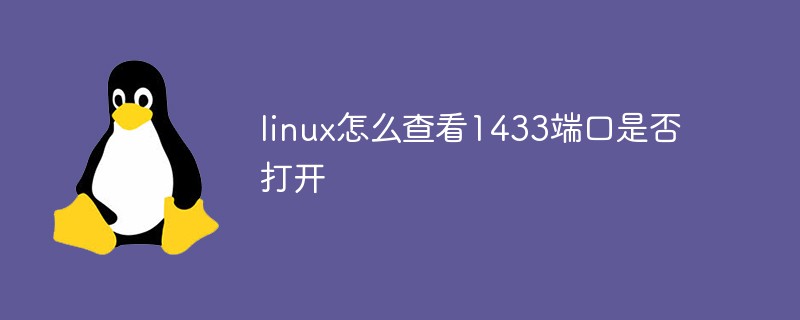 Operation and Maintenance
Operation and Maintenance
 Linux Operation and Maintenance
Linux Operation and Maintenance
 How to check if port 1433 is open in Linux
How to check if port 1433 is open in Linux
How to check if port 1433 is open in Linux
View method: 1. Use the lsof command. This command is used to list all files that have been opened in the system. When the command parameter is set to "-i", you can list the processes that meet the conditions. Syntax It is "lsof -i:1433"; 2. Use the "netstat-aptn" command, which can directly view all opened port numbers and directly check whether the result contains port 1433.

#The operating environment of this tutorial: linux7.3 system, Dell G3 computer.
How to check whether port 1433 is open in Linux
The lsof command is used to check the files opened by your process, the process that opened the file, and the ports opened by the process (TCP, UDP). Retrieve/recover deleted files. It is a very convenient system monitoring tool. Because the lsof command needs to access core memory and various files, it needs to be executed by the root user.
In the Linux environment, everything exists in the form of files. Through files, you can not only access regular data, but also network connections and hardware. Therefore, for example, Transmission Control Protocol (TCP) and User Datagram Protocol (UDP) sockets, the system allocates a file descriptor to the application in the background. Regardless of the nature of the file, the file descriptor is used by the application. Provides a common interface for interaction with the underlying operating system. Because the descriptor list of files opened by an application provides a lot of information about the application itself, being able to view this list through the lsof tool can be helpful for system monitoring and troubleshooting.
Syntax:
lsof(选项)
Options:
-a List the processes that open the file;
-c
-g lists the process details of the GID number;
-d
d< Directory> List the files opened in the directory;
D
-n
-i
The first method:
Use the lsof command
lsof -i:1433
th Two methods:
Use the netstat-aptn command.
Examples are as follows:

Recommended learning: Linux video tutorial
The above is the detailed content of How to check if port 1433 is open in Linux. For more information, please follow other related articles on the PHP Chinese website!

Hot AI Tools

Undresser.AI Undress
AI-powered app for creating realistic nude photos

AI Clothes Remover
Online AI tool for removing clothes from photos.

Undress AI Tool
Undress images for free

Clothoff.io
AI clothes remover

Video Face Swap
Swap faces in any video effortlessly with our completely free AI face swap tool!

Hot Article

Hot Tools

Notepad++7.3.1
Easy-to-use and free code editor

SublimeText3 Chinese version
Chinese version, very easy to use

Zend Studio 13.0.1
Powerful PHP integrated development environment

Dreamweaver CS6
Visual web development tools

SublimeText3 Mac version
God-level code editing software (SublimeText3)

Hot Topics
 1664
1664
 14
14
 1423
1423
 52
52
 1318
1318
 25
25
 1268
1268
 29
29
 1248
1248
 24
24
 Linux Architecture: Unveiling the 5 Basic Components
Apr 20, 2025 am 12:04 AM
Linux Architecture: Unveiling the 5 Basic Components
Apr 20, 2025 am 12:04 AM
The five basic components of the Linux system are: 1. Kernel, 2. System library, 3. System utilities, 4. Graphical user interface, 5. Applications. The kernel manages hardware resources, the system library provides precompiled functions, system utilities are used for system management, the GUI provides visual interaction, and applications use these components to implement functions.
 How to check the warehouse address of git
Apr 17, 2025 pm 01:54 PM
How to check the warehouse address of git
Apr 17, 2025 pm 01:54 PM
To view the Git repository address, perform the following steps: 1. Open the command line and navigate to the repository directory; 2. Run the "git remote -v" command; 3. View the repository name in the output and its corresponding address.
 vscode Previous Next Shortcut Key
Apr 15, 2025 pm 10:51 PM
vscode Previous Next Shortcut Key
Apr 15, 2025 pm 10:51 PM
VS Code One-step/Next step shortcut key usage: One-step (backward): Windows/Linux: Ctrl ←; macOS: Cmd ←Next step (forward): Windows/Linux: Ctrl →; macOS: Cmd →
 How to run sublime after writing the code
Apr 16, 2025 am 08:51 AM
How to run sublime after writing the code
Apr 16, 2025 am 08:51 AM
There are six ways to run code in Sublime: through hotkeys, menus, build systems, command lines, set default build systems, and custom build commands, and run individual files/projects by right-clicking on projects/files. The build system availability depends on the installation of Sublime Text.
 How to run java code in notepad
Apr 16, 2025 pm 07:39 PM
How to run java code in notepad
Apr 16, 2025 pm 07:39 PM
Although Notepad cannot run Java code directly, it can be achieved by using other tools: using the command line compiler (javac) to generate a bytecode file (filename.class). Use the Java interpreter (java) to interpret bytecode, execute the code, and output the result.
 What is the main purpose of Linux?
Apr 16, 2025 am 12:19 AM
What is the main purpose of Linux?
Apr 16, 2025 am 12:19 AM
The main uses of Linux include: 1. Server operating system, 2. Embedded system, 3. Desktop operating system, 4. Development and testing environment. Linux excels in these areas, providing stability, security and efficient development tools.
 laravel installation code
Apr 18, 2025 pm 12:30 PM
laravel installation code
Apr 18, 2025 pm 12:30 PM
To install Laravel, follow these steps in sequence: Install Composer (for macOS/Linux and Windows) Install Laravel Installer Create a new project Start Service Access Application (URL: http://127.0.0.1:8000) Set up the database connection (if required)
 git software installation
Apr 17, 2025 am 11:57 AM
git software installation
Apr 17, 2025 am 11:57 AM
Installing Git software includes the following steps: Download the installation package and run the installation package to verify the installation configuration Git installation Git Bash (Windows only)



